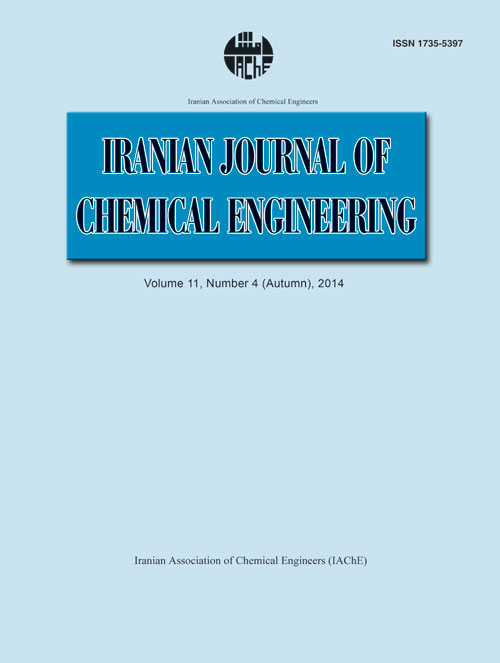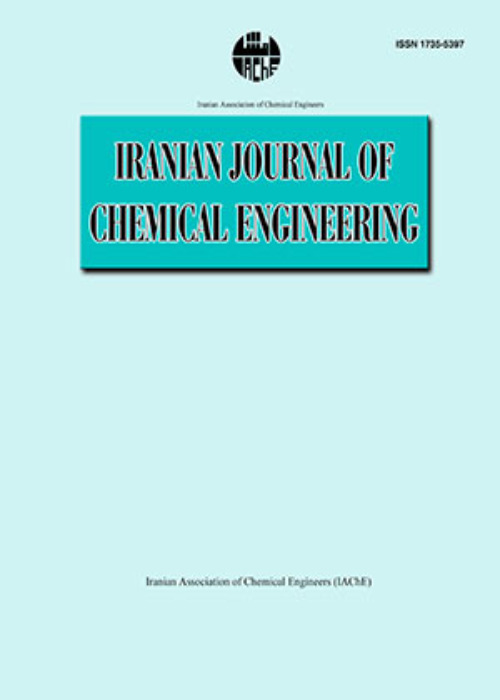فهرست مطالب

Iranian journal of chemical engineering
Volume:11 Issue: 4, Autumn 2014
- تاریخ انتشار: 1394/04/25
- تعداد عناوین: 8
-
-
Pages 3-9In this study, functionalized multi-walled carbon nanotubes using mixed acid treatment were synthesized using solvothermal method by TiCl4 as a precursor and the thermal conductivity enhancement of MWNT-TiO2 nanofluids in various temperatures were compared. The treated nanotubes have been characterized using Fourier Transform Infrared Spectroscopy (FTIR). Hybrid materials were characterized by X-ray diffraction (XRD) and scanning electron microscopy (SEM). The results showed that MWNTs are uniformly decorated with anatase nanocrystals. Temperature effects on thermal conductivity of MWNT-TiO2 nanofluids at different concentrations have beenstudied. The best result showed enhancement of thermal conductivity around 12.1% for the sample with 0.08 wt% of MWNT-TiO2 compared to distilled water at 36°C and 13. 71% at 52°C. Also, zeta potential of 0.02 wt% nanofluids and particle size distribution of nanoparticle were measured.Keywords: Nanofluids, CNT, Hybrid, Thermal Conductivit
-
Pages 10-20In this work, the influence of Red Mud in the pyrolysis of general purpose polystyrene (GPPS) has been studied. The catalytic pyrolysis experiments were carried out using an unstirred semi-batch stainless steel 6.28 liter reactor under nitrogen atmosphere (air free) with Red Mud as a catalyst. The reaction effluents (oil and gases) were condensed in water-cooled condenser. The condensate was weighted to determine the total yield. Gas Chromatography-Mass Spectroscopy (GC-MS) analysis was used to characterize the condensed liquid organic compounds. According to the GC-MS results, styrene, benzene and its derivatives, toluene, naphthalene and a small amount of the other hydrocarbon compounds were identified in condensate liquid. Density, specific gravity,API gravity, kinematics and dynamic viscosity, flash point, fire point, cloud point and pour point of condensate were also measured. Under optimum reaction condition, the yield of pyrolysis reaction was above 90%. The air free reaction condition showed good catalytic pyrolysis of polystyrene with less than 1% coke formation and above 90% selectivity towards formation of aromatic compounds. The specifications of condensate, i.e. density, API gravity, viscosity and flash point observed showed that the liquid obtained can safely be classed as a kerosene. The specific gravity value was close to the specific gravity value of diesel.Keywords: Waste Polystyrene, Catalytic Pyrolysis, Red Mud
-
Pages 21-30The major active component in licorice is glycyrrhizic acid which is very useful in the pharmaceutical industry. In the present work, the extraction of glycyrrhizic acid in licorice is carried out in a stirred reactor as well as under indirect sonication in an ultrasonic bath. Batch extraction is carried out in a glass reactor of 150 mL capacity equipped with a six bladed glass turbine for agitation. Ultrasound assisted extraction has been carried out in a dual frequency ultrasound cleaning bath. The glycyrrhizic acid is analyzed using HPLC. Various process parameters such as solvent concentration, power, frequency of ultrasound, extraction temperature and solvent tosolute ratio, which affect the extraction yield are optimized for both techniques. In ultrasound assisted extraction with final optimized conditions, i.e. 50% ethanol as solvent, 230 W power, 40:1 solvent to solute ratio, 30ºC temperature and 40 kHz frequency, 95.69% extraction is obtained in 20 minutes, whereas in extraction using stirred reactor only 68% extraction is observed in 60 minutes. Kinetic of the extraction process is studied and volumetric mass transfer coefficients as well as theoretical yield for different process parameters are estimated.Keywords: Licorice, Glycyrrhizic Acid, Ultrasound, Kinetics, Optimization
-
Pages 31-39In order to enhance the catalytic performance of SAPO-34 for the reaction of methanol to light olefins (MTO), three different crystallization temperatures were used to synthesize SAPO-34. The catalysts were synthesized hydrothermally with molar composition as 1 Al2O3: 1 P2O5: 0.4 SiO2: 1 TEAOH: 0.5 TEA: 0.5 MOR: 70 H2O. The effects of the crystallization temperature on the phase purity, morphology and functional groups of SAPO-34 were characterized by XRD, SEM and FTIR techniques. The relative crystallinity was decreased by increasing crystallization temperature andsome impurities appeared at high crystallization temperature. All samples showed cubic morphology with different crystal size. The catalytic performance of synthesized SAPO- 34 was investigated in a fixed-bed reactor at 410C. For the MTO reaction, all synthesized catalysts showed similar product distribution and methanol conversion, but light olefins selectivity was greatly dependent on the crystallization condition. The sample was synthesized at 170C and 24 h, possessed the highest light olefins due to highest amount of acid sites, relative crystallinity and smallest mean crystal size.Keywords: SAPO, 34, MTO Process, Crystallization Temperature
-
Pages 40-49TiO2 nanoparticles were pretreated with ethelendiamine (EDA) to synthesize aminefunctionalizedTiO2. The mixed matrix membranes (MMM) comprised of aminfunctionalized TiO2 inside polysulfone (PSf) matrix were fabricated and characterized for gas separation. The effects of the amin-functionalized TiO2 loading on the gas permeation properties of the MMM were investigated by varying the aminfunctionalized TiO2 loading in the PSf matrix from 010 wt%. The fabricated aminfunctionalized TiO2/PSf MMM were characterized by scanning electron microscopy (SEM), Fourier Transform Infrared spectroscopy (FT/IR) and pure gas permeation test. Gas permeation measurement showed that MMMs embedded with different amount of amin-functionalized TiO2 exhibited different separation performances. For example, in MMMs containing 10 wt% amin-functionalized TiO2, the permeability of N2, CH4, CO2 and O2 increased up to 0.69, 0.8, 3.5 and 1.1 GPU respectively. Due to the higher interaction of amine groups on F-nano TiO2 with polar gases, amin-functionalized TiO2 possessed better performances in terms of permeability and selectivity in comparison to pure TiO2. The results revealed that the functionalization of TiO2 has improved the gas permeability of prepared membranes.Keywords: Gas Separation, Nanocomposite Membrane, Functionalized Nano TiO2
-
Pages 50-63This article reports the application of the homogenous UV/ persulfate process, activated with iron copper ions, for the treatment of quinoline (Qu) in aqueous solutions. A photo-reactor with a radial falling solution film around the UV lamp was utilized. Under established optimum conditions of [Qu]0= 40 mg/L, [PS]= 1000 mg/L, pH 6, [Fe2+] / [Cu2+]= 1 mg/L and after 70 min, 88.3%, 94.8% and 96.4% degradations were achieved with UV/PS, UV/PS/Fe2+ and UV/PS/Cu2+ processes, respectively. Accordingly, total organic carbon (TOC) removals were 31.2%, 36.1% and 82.2% after120 min, which highlights the amazing power of copper ions in the treatment. For each case, pseudo first order reactions were obtained for the used processes. The required irradiation energy per cubic meter of aqueous solutions was 127.6, 100.5 and 71.8 kWh for the used processes, respectively. Meanwhile, the role of active radicals was investigated using radical scavengers of ethanol and tert-butyl alcohol, indicating about 48.9% contribution of sulfate radicals in the degradation mechanism.Keywords: UV, Persulfate, Quinoline, Falling Film Reactor, Kinetic, Energy Consumption
-
Pages 64-75The growth kinetics of Lactose particles in a top spray, small scale fluidized bed granulator is studied experimentally and the effects of binder flow rate and concentration, nozzle air pressure and the fluidizing air temperature on the growth kinetics of granules are studied. The results have been explained by the aid of sequentially main effects of each parameter in the process. The effect of each operating variable has been discussed in detail, qualitatively.Keywords: Fluidized Bed Granulation, Wetting, Consolidation, Breakage, Size Distribution
-
Page 76


